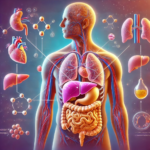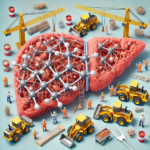💊 Lipogenesis
Lipogenesis is a metabolic process through which the body converts excess carbs into fatty acids so they can then be stored as fat in adipose tissue. Lipogenesis is a very clever process that allows for surplus energy storage from food intake for future use.
The process is very clever because from a purely chemical point of view, storing energy in fat molecules is very efficient. Fat molecules are thin and long, so they fit together nicely like tightly packed pencils in a box. In contrast, both simple and complex carbohydrates are bulky, and their molecular shapes just don’t fit together as nicely. I like to think of fat tissue as a savings account for energy (that requires a lot signatures to access), and glycogen stores as a checking account with a little bit of money that is easy to access and can be used on the spot.
Evolutionary Pathway
In evolutionary terms, lipogenesis is an very ancient survival mechanism. Think about hunter/gatherers in times of abundance and scarcity. We evolved this way because in times of abundance, lipogenesis allows the body to store energy efficiently, ensuring that there is a reserve for periods of scarcity. The problem is that in modern times, this efficiency can be a double-edged sword, because food is not only plentiful and readily available at all times, but there is also a lot of items with unnaturally high glycemic index, and plainly said, we didn’t evolve to be able to handle that.
This problem has lead in many cases to excessive fat storage and related health issues such as obesity, diabetes, cardiovascular disease, and metabolic syndrome, among many others. Understanding the biochemistry behind lipogenesis highlights the importance of balanced nutrition and lifestyle choices to manage energy storage and maintain metabolic health.
Lipogenesis Biochemistry
Lipogenesis primarily occurs in the liver and, to a lesser extent, in adipose tissue itself. The process begins with extra glucose after that big ass tub of ice cream at midnight being converted into pyruvate through glycolysis. Pyruvate is then transported into the mitochondria, where it is converted to acetyl-CoA. In the cytoplasm, acetyl-CoA is carboxylated by the enzyme acetyl-CoA carboxylase (the rate-limiting step of fatty acid synthesis) to form malonyl-CoA, which serves as a building block for fatty acid chains. These chains are elongated through a series of reactions catalyzed by fatty acid synthase, eventually leading to the formation of palmitate, a 16-carbon saturated fatty acid.
Once synthesized, these fatty acids are esterified with glycerol to form triglycerides, which are then packaged and stored in adipose tissue. This entire process is highly energy-dependent, consuming ATP and NADPH, which are derived from other metabolic pathways like the pentose phosphate pathway. The regulation of lipogenesis is tightly controlled by hormonal signals, particularly insulin, which promotes the uptake of glucose and stimulates enzymes involved in fatty acid synthesis, especially after meals when glucose levels are high. Insulin acts by upregulating key enzymes such as acetyl-CoA carboxylase and fatty acid synthase, while glucagon and epinephrine inhibit this process, promoting lipolysis instead.
🤔 Why you need to know:
Understanding lipogenesis is important because it helps explain how the body stores excess calories as fat and the implications for weight management and metabolic health. Here are some key points and actionable tips:
- Role in Weight Gain: Excessive carbohydrate intake, particularly from sugars and refined carbs, can accelerate lipogenesis, leading to increased fat storage. This process plays a significant role in weight gain and the development of obesity.
- Impact on Metabolic Health: Chronic overactivation of lipogenesis, often driven by a high-carb, high-calorie diet, can contribute to insulin resistance, fatty liver disease, and other metabolic disorders.
- Hormonal Regulation: Insulin is a key regulator of lipogenesis, promoting fat storage after meals. Managing insulin levels through diet and lifestyle changes can influence how much fat your body stores.
Actionable Tips (Easy on the carbs, Superstar):
- Moderate Carbohydrate Intake: Focus on complex carbohydrates like whole grains, vegetables, and legumes, which are digested more slowly and have a less pronounced effect on insulin and fat storage.
- Incorporate Healthy Fats: Consuming healthy fats from sources like avocados, nuts, and olive oil can help regulate lipogenesis by modulating insulin sensitivity and providing a source of energy that doesn’t spike insulin levels.
- Engage in Regular Physical Activity: Exercise helps improve insulin sensitivity and shifts the body’s energy balance away from storage (lipogenesis) toward utilization (lipolysis), aiding in weight management.
Remember, while it’s true that excess carbohydrates, especially refined ones, can lead to fat storage, dietary fat can also contribute to fat accumulation if consumed in excess. Belly fat, or visceral fat, is influenced by overall caloric intake and lifestyle factors – its all chemistry, really… or physics, rather – Thermodynamics.
🧠 Trivia:
Lipogenesis is so efficient at converting excess energy into fat that even small amounts of excess caloric intake over time can lead to significant weight gain – illustrating the importance of a balanced diet and consistency.



